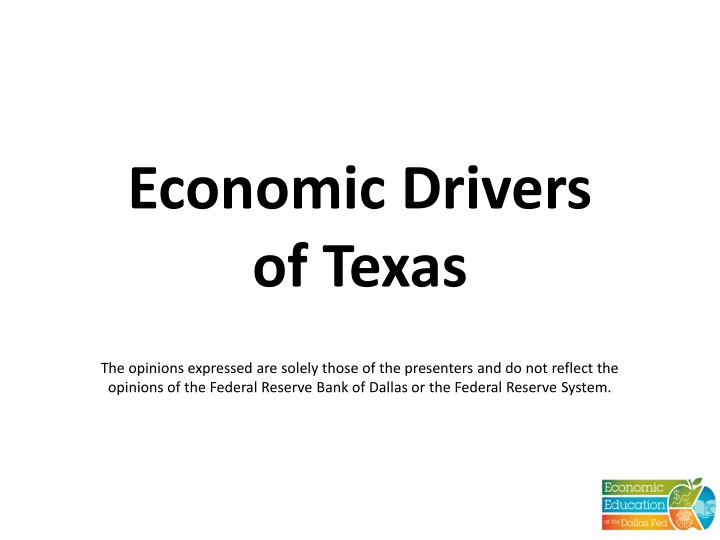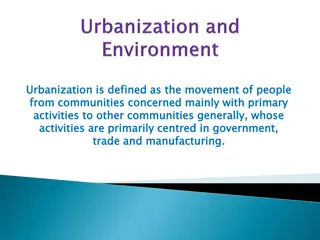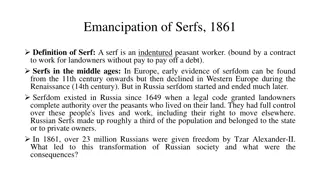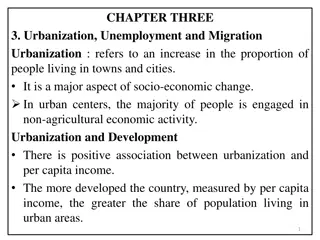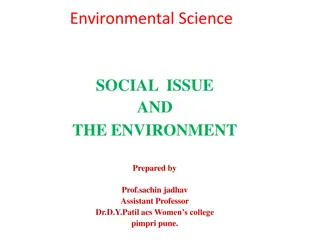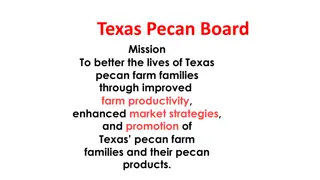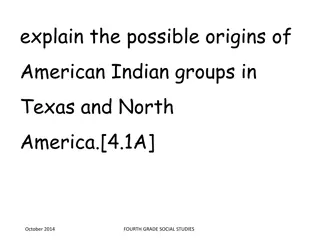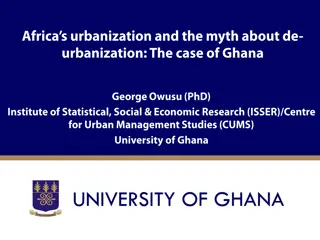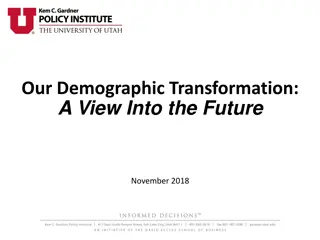Economic Transformation in Texas: Urbanization Trends
Urbanization has reshaped the Texas economy, shifting from traditional industries like cattle and oil to a focus on urban job centers. Major industries such as transportation and manufacturing have fueled this transformation. Understand the economic factors driving Texas' evolution and the interdependence of its economy with national and global markets. Explore the impacts of industries like oil and gas, aerospace, medical, and technology on local, national, and international economies through data analysis and business patterns.
Download Presentation

Please find below an Image/Link to download the presentation.
The content on the website is provided AS IS for your information and personal use only. It may not be sold, licensed, or shared on other websites without obtaining consent from the author.If you encounter any issues during the download, it is possible that the publisher has removed the file from their server.
You are allowed to download the files provided on this website for personal or commercial use, subject to the condition that they are used lawfully. All files are the property of their respective owners.
The content on the website is provided AS IS for your information and personal use only. It may not be sold, licensed, or shared on other websites without obtaining consent from the author.
E N D
Presentation Transcript
Economic Drivers of Texas The opinions expressed are solely those of the presenters and do not reflect the opinions of the Federal Reserve Bank of Dallas or the Federal Reserve System.
TEKS (7thGrade Texas History) (12) Economics. The student understands the factors that caused Texas to change from an agrarian to an urban society. The student is expected to: (A) explain economic factors that led to the urbanization of Texas; (B) trace the development of major industries that contributed to the urbanization of Texas such as transportation, oil and gas, and manufacturing; and (C) explain the changes in the types of jobs and occupations that have resulted from the urbanization of Texas.
TEKS (7thGrade Texas History) (13) Economics. The student understands the interdependence of the Texas economy with the United States and the world. The student is expected to: (A) analyze the impact of national and international markets and events on the production of goods and services in Texas such as agriculture, oil and gas, and computer technology; (B) analyze the impact of economic concepts within the free enterprise system such as supply and demand, profit, government regulation, and world competition on the economy of Texas; and (C) analyze the impact of significant industries in Texas such as oil and gas, aerospace, medical, and computer technologies on local, national, and international markets.
Urbanization Urbanization is the story of a transformation of the Texas economy. Old story of cattle, cotton and oil has given way to a new narrative. New story is driven by jobs in the urban centers.
Where Texans Work County Business Patterns (CBP) examines local economic data by industry. Number of firms Number of paid employees Payroll Uses North American Industry Classification System (NAICS) Excludes farming and railroads, along with household jobs http://www.census.gov/econ/cbp/index.html
Top 5 Industries by Number of Firms Industry Number of firms Retail trade 76,787 Professional, scientific, and technical services 59,757 Health care and social assistance 59,193 Other services (except public administration) 48,097 Accommodation and food services 46,045
Top 5 Industries by Employees Paid employees Industry Health care and social assistance 1,280,332 Retail trade 1,127,032 Accommodation and food services 908,665 Waste management and remediation services 830,284 Manufacturing 730,551
Top 6 Industries by Payroll Annual payroll ($1,000) Industry Health care and social assistance 51,168,478 Professional, scientific, and technical services 40,436,455 Manufacturing 38,849,364 Finance and insurance 28,870,504 Management of companies and enterprises 28,811,285 Wholesale trade 28,125,856
Two Lenses The CBP data looks at how big various sectors are in Texas. Concentration is a different way to measure the impact.
Industry Clusters Geographically concentrated groups of companies related by the technologies they use the markets they serve the goods and services they produce the labor skills they require
Location Quotient Ratio of Local Employment Concentration to National Concentration within a sector. Numbers greater than 1 indicate a greater concentration than the nation as a whole. Numbers less than 1 indicate a lesser concentration than the nation as a whole.
Top Five Industry Clusters Industry Location Quotient Oil and gas extraction 5.9 Support activities for mining 5.6 Pipeline transportation 4.33 Funds, trusts and other financial vehicles 2.78 Petroleum and coal products manufacturing 2.78
The Rest of the Top Ten Industry Location Quotient Air transportation 1.67 Leather and allied product manufacturing 1.54 Support activities for transportation 1.51 Information and data processing services 1.42 Fishing, hunting and trapping 1.32
The Next Five Industry Location Quotient Computer and electronic product manufacturing Wholesale trade, durable goods 1.24 1.21 Broadcasting and telecommunications 1.2 Management of companies and enterprises 1.18 Nonmetallic mineral product manufacturing 1.15
Economic Drivers Energy Services Manufacturing
Austin Computer and electronic product manufacturing 4.09 Publishing industries 2.01 Information and data processing services 1.78 Wholesale trade, durable goods 1.63 Lessors of nonfinancial intangible assets 1.57
Dallas-Fort Worth Oil and gas extraction 3.05 Air transportation 2.78 Information and data processing services 2.45 Computer and electronic product manufacturing 2.11 Funds, trusts and other financial vehicles 1.82
Houston Pipeline transportation 10.22 Oil and gas extraction 8.44 Funds, trusts and other financial vehicles 8.29 Petroleum and coal products manufacturing 5.08 Support activities for mining 5.07
San Antonio Leather and allied product manufacturing 7.86 Information and data processing services 2.2 Management of companies and enterprises 1.79 Insurance carriers and related activities 1.65 Pipeline transportation 1.53
Texas Wide Open for Business Advanced Technology & Manufacturing Aerospace, Aviation & Defense Biotechnology & Life Sciences Information & Computer Technology Petroleum Refining & Chemical Products Energy http://www.texaswideopenforbusiness.com/ind ustries/index.php
Economic Drivers Energy ??? Services Manufacturing
Texas Exports (millions of dollars) 264,709 250,662 206,992 162,995 2009 Value 2010 Value 2011 Value 2012 Value
Texas Top Markets Mexico Canada China Brazil Netherlands South Korea Singapore Colombia Japan Belgium
Economic Drivers Energy Exports Services Manufacturing
For more information For data about the regional and national economy, see: www.dallasfed.org For information about key Texas industries, see: http://www.texaswideopenforbusiness.com/industries/index.php For industry profiles, see: http://governor.state.tx.us/ecodev/business_research/industry_profil es/%20 To learn about industry classifications, see: http://www.bls.gov/iag/home.htm For export data, see: http://www.census.gov/foreign-trade/statistics/state/data/tx.html
